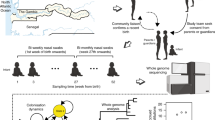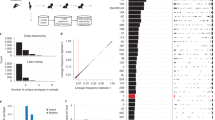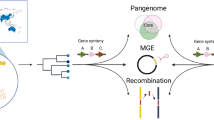Abstract
Evasion of clinical interventions by Streptococcus pneumoniae occurs through selection of non-susceptible genomic variants. We report whole-genome sequencing of 3,085 pneumococcal carriage isolates from a 2.4-km2 refugee camp. This sequencing provides unprecedented resolution of the process of recombination and its impact on population evolution. Genomic recombination hotspots show remarkable consistency between lineages, indicating common selective pressures acting at certain loci, particularly those associated with antibiotic resistance. Temporal changes in antibiotic consumption are reflected in changes in recombination trends, demonstrating rapid spread of resistance when selective pressure is high. The highest frequencies of receipt and donation of recombined DNA fragments were observed in non-encapsulated lineages, implying that this largely overlooked pneumococcal group, which is beyond the reach of current vaccines, may have a major role in genetic exchange and the adaptation of the species as a whole. These findings advance understanding of pneumococcal population dynamics and provide information for the design of future intervention strategies.
This is a preview of subscription content, access via your institution
Access options
Subscribe to this journal
Receive 12 print issues and online access
$209.00 per year
only $17.42 per issue
Buy this article
- Purchase on Springer Link
- Instant access to full article PDF
Prices may be subject to local taxes which are calculated during checkout




Similar content being viewed by others
References
O'Brien, K.L. & Nohynek, H. Report from a WHO Working Group: standard method for detecting upper respiratory carriage of Streptococcus pneumoniae. Pediatr. Infect. Dis. J. 22, e1–e11 (2003).
Adetifa, I.M. et al. Pre-vaccination nasopharyngeal pneumococcal carriage in a Nigerian population: epidemiology and population biology. PLoS ONE 7, e30548 (2012).
Hanage, W.P. et al. Evidence that pneumococcal serotype replacement in Massachusetts following conjugate vaccination is now complete. Epidemics 2, 80–84 (2010).
Croucher, N.J. et al. Rapid pneumococcal evolution in response to clinical interventions. Science 331, 430–434 (2011).
Croucher, N.J. et al. Population genomics of post-vaccine changes in pneumococcal epidemiology. Nat. Genet. 45, 656–663 (2013).
Steinmoen, H., Knutsen, E. & Havarstein, L.S. Induction of natural competence in Streptococcus pneumoniae triggers lysis and DNA release from a subfraction of the cell population. Proc. Natl. Acad. Sci. USA 99, 7681–7686 (2002).
Hanage, W.P., Fraser, C., Tang, J., Connor, T.R. & Corander, J. Hyper-recombination, diversity, and antibiotic resistance in pneumococcus. Science 324, 1454–1457 (2009).
Hiller, N.L. et al. Generation of genic diversity among Streptococcus pneumoniae strains via horizontal gene transfer during a chronic polyclonal pediatric infection. PLoS Pathog. 6, e1001108 (2010).
Eldholm, V., Johnsborg, O., Haugen, K., Ohnstad, H.S. & Havarstein, L.S. Fratricide in Streptococcus pneumoniae: contributions and role of the cell wall hydrolases CbpD, LytA and LytC. Microbiology 155, 2223–2234 (2009).
Wei, H. & Havarstein, L.S. Fratricide is essential for efficient gene transfer between pneumococci in biofilms. Appl. Environ. Microbiol. 78, 5897–5905 (2012).
Donkor, E.S. et al. High levels of recombination among Streptococcus pneumoniae isolates from the Gambia. mBio 2, e00040–11 (2011).
Turner, P. et al. A longitudinal study of Streptococcus pneumoniae carriage in a cohort of infants and their mothers on the Thailand-Myanmar border. PLoS ONE 7, e38271 (2012).
Turner, C. et al. High rates of pneumonia in children under two years of age in a South East Asian refugee population. PLoS ONE 8, e54026 (2013).
Cheng, L., Connor, T.R., Siren, J., Aanensen, D.M. & Corander, J. Hierarchical and spatially explicit clustering of DNA sequences with BAPS Software. Mol. Biol. Evol. 30, 1224–1228 (2013).
Corander, J., Marttinen, P., Siren, J. & Tang, J. Enhanced Bayesian modelling in BAPS software for learning genetic structures of populations. BMC Bioinformatics 9, 539 (2008).
Salter, S.J. et al. Variation at the capsule locus, cps, of mistyped and non-typable Streptococcus pneumoniae isolates. Microbiology 158, 1560–1569 (2012).
Hsieh, Y.C. et al. Serotype competence and penicillin resistance in Streptococcus pneumoniae. Emerg. Infect. Dis. 12, 1709–1714 (2006).
Zapun, A., Contreras-Martel, C. & Vernet, T. Penicillin-binding proteins and β-lactam resistance. FEMS Microbiol. Rev. 32, 361–385 (2008).
Adrian, P.V. & Klugman, K.P. Mutations in the dihydrofolate reductase gene of trimethoprim-resistant isolates of Streptococcus pneumoniae. Antimicrob. Agents Chemother. 41, 2406–2413 (1997).
Padayachee, T. & Klugman, K.P. Novel expansions of the gene encoding dihydropteroate synthase in trimethoprim-sulfamethoxazole-resistant Streptococcus pneumoniae. Antimicrob. Agents Chemother. 43, 2225–2230 (1999).
Silver, L.L. Multi-targeting by monotherapeutic antibacterials. Nat. Rev. Drug Discov. 6, 41–55 (2007).
Hoge, C.W., Gambel, J.M., Srijan, A., Pitarangsi, C. & Echeverria, P. Trends in antibiotic resistance among diarrheal pathogens isolated in Thailand over 15 years. Clin. Infect. Dis. 26, 341–345 (1998).
O'Brien, K.L. & Nohynek, H. Report from a WHO working group: standard method for detecting upper respiratory carriage of Streptococcus pneumoniae. Pediatr. Infect. Dis. J. 22, 133–140 (2003).
Zerbino, D.R. & Birney, E. Velvet: algorithms for de novo short read assembly using de Bruijn graphs. Genome Res. 18, 821–829 (2008).
Boetzer, M., Henkel, C.V., Jansen, H.J., Butler, D. & Pirovano, W. Scaffolding pre-assembled contigs using SSPACE. Bioinformatics 27, 578–579 (2011).
Boetzer, M. & Pirovano, W. Toward almost closed genomes with GapFiller. Genome Biol. 13, R56 (2012).
Li, H. & Durbin, R. Fast and accurate short read alignment with Burrows-Wheeler transform. Bioinformatics 25, 1754–1760 (2009).
Langmead, B., Trapnell, C., Pop, M. & Salzberg, S.L. Ultrafast and memory-efficient alignment of short DNA sequences to the human genome. Genome Biol. 10, R25 (2009).
Croucher, N.J. et al. Role of conjugative elements in the evolution of the multidrug-resistant pandemic clone Streptococcus pneumoniaeSpain23F ST81. J. Bacteriol. 191, 1480–1489 (2009).
Harris, S.R. et al. Evolution of MRSA during hospital transmission and intercontinental spread. Science 327, 469–474 (2010).
Corander, J., Waldmann, P. & Sillanpaa, M.J. Bayesian analysis of genetic differentiation between populations. Genetics 163, 367–374 (2003).
Corander, J. & Tang, J. Bayesian analysis of population structure based on linked molecular information. Math. Biosci. 205, 19–31 (2007).
Tang, J., Hanage, W.P., Fraser, C. & Corander, J. Identifying currents in the gene pool for bacterial populations using an integrative approach. PLoS Comput. Biol. 5, e1000455 (2009).
Corander, J., Connor, T.R., O'Dwyer, C.A., Kroll, J.S. & Hanage, W.P. Population structure in the Neisseria, and the biological significance of fuzzy species. J. R. Soc. Interface 9, 1208–1215 (2011).
Mutreja, A. et al. Evidence for several waves of global transmission in the seventh cholera pandemic. Nature 477, 462–465 (2011).
Cheng, L., Connor, T.R., Siren, J., Aanensen, D.M. & Corander, J. Hierarchical and spatially explicit clustering of DNA sequences with BAPS software. Mol. Biol. Evol. 30, 1224–1228 (2013).
Willems, R.J. et al. Restricted gene flow among hospital subpopulations of Enterococcus faecium. mBio 3, e00151–12 (2012).
Price, M.N., Dehal, P.S. & Arkin, A.P. FastTree 2—approximately maximum-likelihood trees for large alignments. PLoS ONE 5, e9490 (2010).
Drummond, A.J. & Rambaut, A. BEAST: Bayesian evolutionary analysis by sampling trees. BMC Evol. Biol. 7, 214 (2007).
Feil, E.J., Maiden, M.C., Achtman, M. & Spratt, B.G. The relative contributions of recombination and mutation to the divergence of clones of Neisseria meningitidis. Mol. Biol. Evol. 16, 1496–1502 (1999).
Stamatakis, A. RAxML-VI-HPC: maximum likelihood–based phylogenetic analyses with thousands of taxa and mixed models. Bioinformatics 22, 2688–2690 (2006).
Smith, A.M. & Klugman, K.P. Alterations in MurM, a cell wall muropeptide branching enzyme, increase high-level penicillin and cephalosporin resistance in Streptococcus pneumoniae. Antimicrob. Agents Chemother. 45, 2393–2396 (2001).
Letunic, I. & Bork, P. Interactive Tree Of Life v2: online annotation and display of phylogenetic trees made easy. Nucleic Acids Res. 39, W475–W478 (2011).
Krzywinski, M. et al. Circos: an information aesthetic for comparative genomics. Genome Res. 19, 1639–1645 (2009).
Acknowledgements
We thank the microbiology and clinical team in the Shoklo Malaria Research Unit, part of the Mahidol Oxford University Research Unit, Faculty of Tropical Medicine, Mahidol University, Thailand, and the core informatics, library-generating and sequencing teams at the Wellcome Trust Sanger Institute. Attending authors are grateful for the opportunity for discussion at the Permafrost workshop. C.C. was funded by a Royal Thai Government scholarship and a Wellcome Trust PhD studentship. J.C., P.M., A.P. and L.C. were funded by Academy of Finland grant 251170 and European Research Council grant 239784. S.D.B. is partly funded by the National Institute for Health Research (NIHR) Cambridge Biomedical Research Centre. P.T. was funded by Wellcome Trust grant 083735/Z/07Z. This work is sponsored by Wellcome Trust grant 098051.
Author information
Authors and Affiliations
Contributions
S.D.B., P.T., J.P., D.G. and F.N. conceived the study. P.T. and C.T. collected and provided the samples for the study. J.P., S.D.B., C.C., S.R.H., N.J.C. and J.C. designed the analyses. C.C., S.R.H., P.M., L.C., A.P., D.M.A., A.E.M., A.J.P., S.J.S., D.H. and J.C. performed the analyses. C.C., S.D.B., S.R.H., A.E.M. and N.J.C. wrote the manuscript. All authors read and approved the manuscript.
Corresponding author
Ethics declarations
Competing interests
The authors declare no competing financial interests.
Integrated supplementary information
Supplementary Figure 1 Association between recombining pbp genes and resistant phenotypes.
(a) pbp1a gene tree. (b) pbp2b gene tree. (c) pbp2x gene tree. The inner ring is colored according to dominant population clusters (BC1–7), with the rest of the population appearing in white. The outer ring is colored according to resistance to penicillin with black and white showing non-susceptibility and susceptibility, respectively.
Supplementary Figure 2 All possible recombination donors for recombinant fragments detected in one isolate.
Top panel: nine predicted recombination fragments in SMRU1452 (fragments A–I) are highlighted in different colors and are ordered according to their locations on the genome with their size labeled. Bottom panel: the bar chart presents the possible sources of each recombinant fragment based on the above color scheme. The y axis gives the proportion of hits detected per population of particular lineage. For example, recombination fragment A of 1,236 bp in length was found to have identical matches in 96.29%, 75%, 70.59%, 69.84%, 10% and 8.33% of the population of secondary BAPS clusters of serotype 11A, 15B, 34, 6B, NT and 16F, respectively.
Supplementary Figure 3 Potential donors characterized by isolated and by BAPS primary clusters.
(a) Boxplots represent distribution of donation probability of isolates within each cluster. A red bar represents a mean frequency of donation event of any isolates (2.53 × 10–5), i.e., each isolate has a probability of 1/39,537 to donate DNA in a recombination event. (b) and (c) respectively show positive correlations between potential donor clusters (based on primary BAPS clusters) and outer population size, and separately cluster diversity.
Supplementary Figure 4 Single-nucleotide polymorphism (SNPs)-based phylogeny using method described in Croucher et al.
Each panel represents a major Maela cluster: (a) BC1-19F, (b) BC2-23F, (c) BC3-NT, (d) BC4-6B, (e) BC5-23A/F, (f) BC6-15B/C and (g) BC7-14. Subclades where substitution rates were estimated are highlighted in different colors and labeled accordingly. Please note that substitution rates cannot be confidently estimated from any clades in BC6-15B/C. The scale bar represents the number of SNPs.
Supplementary Figure 5 Demonstration that clocklike signals can be detected from the subclades but not from the whole population.
Each dominant cluster is comprised of more than a single subclade that coevolve together. This plot used BC5-23A/F as an example. The clock signal cannot be detected in the whole cluster as there is confounding from the signals of the subclades.
Supplementary Figure 6 Clocklike signals from Path-O-Gen in the subclades where substitution rates were estimated.
These subclades were highlighted in Supplementary Figure 4. The y axis reports root-to tip divergence while the x axis represents the time scale in days from the first date of collection, which was 12 November 2007. The first date (time = 0) is shown as a vertical dashed line.
Supplementary Figure 7 Recombination per mutation (r/m) of each cluster calculated by linear regression.
Due to the large sample size available in our studies, we alternatively calculated the ratio of recombination events (y axis) over point mutations (x axis) observed on each branch from the slope (r/m) of the linear regression. The number is tabulated in Supplementary Table 4. For comparison of r/m by linear regression, all the data are ranked to accommodate the non-parametric ANCOVA analysis.
Supplementary Figure 8 Comparison of two recombination-detecting methods.
(a) Genome view of recombination fragments predicted by both algorithms. Recombination regions are aligned with taxa on the phylogenetic tree (left). Genome coordinates are labeled on top. Recombination regions exclusively predicted by methods described in Croucher et al. and Marttinen et al. are highlighted in red and blue, respectively. Overlapping regions predicted by both algorthms are highlighted in dark grey. (b) A histogram showing the length of recombination fragments (bp) predicted by two algorithms. (c) Sequence quality of recombination fragments predicted by two algorithms reported as percent “N”. For (b) and (c), fragments predicted by tools described in Croucher et al. and Marttinen et al. are shaded in red and blue, respectively. The values given by (b) and (c) are summarized in (d).
Supplementary Figure 9 Identifying donor blocks from recipient block identity.
Donor blocks are sequences that show identical matching to the recipient blocks. (a) A histogram showing distribution of length of recipient blocks from recombination events detected at the tip of the phylogenies. Shaded in gray are all recipient blocks used as queries for blast searches. In white are recipient blocks where identical hits were detected from the rest of the population. (b) Summarization of the values from distribution in (a). (c) A plot showing association between the length of sequence queries (recipient blocks) and the diversity of detected hits (potential donor blocks classified by secondary BAPS clusters). The data was modeled as exponential decay with the line of best fit (red line) and the 95% confidence interval (dashed red lines).
Supplementary information
Supplementary Text and Figures
Supplementary Figures 1–9, Supplementary Tables 2–9 and Supplementary Note. (PDF 4563 kb)
Supplementary Table 1
Epidemiological data associated with strains and accession codes associated with data deposited in the European Nucleotide Archive. (XLS 543 kb)
Rights and permissions
About this article
Cite this article
Chewapreecha, C., Harris, S., Croucher, N. et al. Dense genomic sampling identifies highways of pneumococcal recombination. Nat Genet 46, 305–309 (2014). https://doi.org/10.1038/ng.2895
Received:
Accepted:
Published:
Issue Date:
DOI: https://doi.org/10.1038/ng.2895
This article is cited by
-
Genomic and panproteomic analysis of the development of infant immune responses to antigenically-diverse pneumococci
Nature Communications (2024)
-
Leaky barriers to gene sharing between locally co-existing coagulase-negative Staphylococcus species
Communications Biology (2023)
-
A bacterial pan-genome makes gene essentiality strain-dependent and evolvable
Nature Microbiology (2022)
-
Frequencies and characteristics of genome-wide recombination in Streptococcus agalactiae, Streptococcus pyogenes, and Streptococcus suis
Scientific Reports (2022)
-
Pneumococcal within-host diversity during colonization, transmission and treatment
Nature Microbiology (2022)



